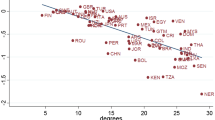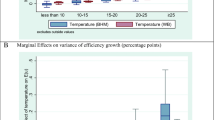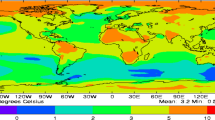Abstract
We investigate the influence of weather on countries’ GDP and their main components of production, namely total factor productivity, capital stock, and employment. Our panel dataset includes annual observations on 103 countries for the period 1961–2010. We find that the main impacts of weather occur through temperature and drive the growth in GDP. Our results show that, for higher levels of temperature, the poor countries are much more strongly impacted than the rich countries. We also find that weather impacts per capita GDP growth through all its factors of production, with the largest impacts on total factor productivity. Again it is the poor countries for which these impacts are the strongest. The findings provide empirical evidence for negative impacts of temperature on economic growth and its factors of production and furthermore point towards climate change as an important driver of international inequality.


Similar content being viewed by others
Notes
If we use a similar cutoff point as Burke et al. (2015) in order to distinguish between rich and poor, then we also do not find a difference between rich and poor countries.
Another factor of production is human capital. However, there is no annual data on human capital, but instead, it is only available at 5-year intervals and then gets interpolated to the annual level. Thus, this variable would not be useful for our purposes.
We also run robustness of this cutoff point.
Also, in this kind of approach, a system of equations faces many problems. Firstly, issues result from the convergence due to the large amount of dummies and trend variables. Secondly, a system of equations that uses the same independent variables would yield the same empirical results as running each regression separately. Thus, in order to make a system of equations meaningful, one would need to use restrictions. Suitable restrictions can only be obtained from a deep model. This is an entirely different, although viable and complementary, approach.
In general, total factor productivity represents our “measure of ignorance,” and it comprises as diverse factors such as technological progress or structural changes.
The quantitative differences in the results might be caused by different datasets used. Burke et al. (2015) used data from the World Development Indicators and from the Penn World Tables as robustness. Our results do not fully correspond to theirs from the Penn World Tables as they used a previous version of this dataset.
Using log differences as Burke et al. (2015) instead of the actual growth rate increases the turning point to 11 °C.
We are cautious to interpret the seemingly negative relationship between temperature and the growth of capital stock for very low levels of temperature levels, since this finding results from few observations.
The only exception being a marginally significant temperature lag at t − 2, while the t − 1 lag is not significant.
Anomalies are calculated as \( {x}_{it}^a=\left({x}_{it}-\overline{x_i}\right)/ sd{(x)}_i \), where \( {x}_{it}^a \) is the anomaly of the climatic variable x in country i at t, xit is the country-time specific observation \( \overline{x_i} \) is the country-specific average of xit over the time horizon, and sd(x)i is the country-specific standard deviation of the variable during the sample.
How precisely climate policy then should address the various impacts is more a microeconomic question that a macroeconomic study such as ours cannot answer.
References
Acemoglu D (2008) Introduction to modern economic growth. Princeton University Press
Barrios S, Bertinelli L, Strobl E (2010) Trends in rainfall and economic growth in Africa: a neglected cause of the African growth tragedy. Rev Econ Stat 92(2):350–366
Belasen AR, Polachek SW (2008) How hurricanes affect wages and employment in local labor markets. Am Econ Rev 98(2):49–53
Burke M, Hsiang SM, Miguel E (2015) Global non-linear effect of temperature on economic production. Nature
CIESIN (n.d.) Gridded population of the world, Version 3
Dell M, Jones B, Olken B (2009) Temperature and income: reconciling new cross-sectional and panel estimates. Am Econ Rev Pap Proc 99(2):198–204
Dell M, Jones BF, Olken BA (2012) Temperature shocks and economic growth: evidence from the last half century. Am Econ J Macroecon 4(3):66–95
Dell M, Jones BF, Olken BA (2014) What do we learn from the weather? The new climate–economy literature. J Econ Lit 52(3):740–798
Dennig F, Budolfson MB, Fleurbaey M, Siebert A, Socolow RH (2015) Inequality, climate impacts on the future poor, and carbon prices. Proc Natl Acad Sci 112(52):15827–15832
Desbureaux S, Rodella A-S (2019) Drought in the city: the economic impact of water scarcity in Latin American metropolitan areas. World Dev 114:13–27
Di Falco S, Veronesi M, Yesuf M (2011) Does adaptation to climate change provide food security? A micro-perspective from Ethiopia. Am J Agric Econ 93(3):829–846
Dietz S, Stern N (2015) Endogenous growth, convexity of damage and climate risk: how Nordhaus' framework supports deep cuts in carbon emissions. Econ J 125(583):574–620
Easterly W, Levine R (2001) It’s not factor accumulation: stylized facts and growth models. World Bank Econ Rev 15(2):177–219
Edgington E, Onghena P (2007) Randomization tests. Chapman and Hall/CRC
Fankhauser S, Tol RSJ (2005) On climate change and economic growth. Resour Energy Econ 27(1):1–17
Fankhauser S, Sahni A, Savvas A, Ward J (2016) Where are the gaps in climate finance? Climate Dev 8(3):203–206
Feenstra RC, Inklaar R, Timmer MP (2015) The next generation of the Penn World Table. Am Econ Rev 105(10):3150–3182
Foster L, Haltiwanger JC, Krizan CJ (2001) Aggregate productivity growth: lessons from microeconomic evidence. New developments in productivity analysis. University of Chicago Press, pp 303–372
Greene C (2018) Broadening understandings of drought—the climate vulnerability of farmworkers and rural communities in California (USA). Environ Sci Pol 89:283–291
Hisali E, Birungi P, Buyinza F (2011) Adaptation to climate change in Uganda: evidence from micro level data. Glob Environ Chang 21(4):1245–1261
PCC (2007) Climate change 2007: impacts, adaptation and vulnerability. In: Parry ML, Canziani OF, Palutikof JP, van der Linden PJ, Hanson CE (eds) Contribution of working Group II to the fourth assessment report of the intergovernmental panel on climate change. Cambridge University Press, Cambridge, UK, pp 976
IPCC (2014) Climate change 2014: synthesis report. In: Core Writing Team, Pachauri RK, Meyer LA (eds) Contribution of working Groups I, II and III to the fifth assessment report of the intergovernmental panel on climate change. IPCC, Geneva, Switzerland, pp 151
IPCC (2018) Summary for policymakers. In: Masson-Delmotte V, Zhai P, Pörtner H-O, Roberts D, Skea J, Shukla PR, Pirani A, Moufouma-Okia W, Péan C, Pidcock R, Connors S, Matthews JBR, Chen Y, Zhou X, Gomis MI, Lonnoy E, Maycock T, Tignor M, Waterfield T (eds) Global warming of 1.5°C. An IPCC special report on the impacts of global warming of 1.5°C above pre-industrial levels and related global greenhouse gas emission pathways, in the context of strengthening the global response to the threat of climate change, sustainable development, and efforts to eradicate poverty. World Meteorological Organization, Geneva, Switzerland, pp 32
Jensen R (2000) Agricultural volatility and investments in children. Am Econ Rev 90(2):399–404
Letta M, Tol RSJ (2018) Weather, climate and total factor productivity. Environ Resour Econ
Letta M, Montalbano P, Tol RSJ (2018) Temperature shocks, short-term growth and poverty thresholds: evidence from rural Tanzania. World Dev 112:13–32
Marchiori L, Maystadt J-F, Schumacher I (2017) Is environmentally induced income variability a driver of human migration? Migr Dev 6(1):33–59
Mariani F, Pйrez-Barahona A, Raffin N (2010) Life expectancy and the environment. J Econ Dyn Control 34(4):798–815
Matsuura K, Willmott CJ (2012) Terrestrial air temperature and precipitation: monthly and annual time series (1900–2010) v 3.01. University of Delaware
Nordhaus WD (2010) Modeling induced innovation in climate-change policy. Technological change and the environment. Routledge, pp 188–215
Pielke RA Jr (1998) Rethinking the role of adaptation in climate policy. Glob Environ Chang 8(2):159–170
Roberts JT (2001) Global inequality and climate change. Soc Nat Resour 14(6):501–509
Schlenker W, Roberts MJ (2009) Nonlinear temperature effects indicate severe damages to US crop yields under climate change. Proc Natl Acad Sci 106(37):15594–15598
Strobl E (2011) The economic growth impact of hurricanes: evidence from US coastal counties. Rev Econ Stat 93(2):575–589
Temple J (1999) The new growth evidence. J Econ Lit 37(1):112–156
Tol RSJ (2018) The economic impacts of climate change. Rev Environ Econ Policy 12(1):4–25
Villavicencio X, McCarl BA, Wu X, Huffman WE (2013) Climate change influences on agricultural research productivity. Clim Chang 119(3):815–824
Withagen C (2014) The climate change, migration and conflict nexus. Environ Dev Econ 19(3):324–327
Zhang P, Deschenes O, Meng K, Zhang J (2018) Temperature effects on productivity and factor reallocation: evidence from a half million chinese manufacturing plants. J Environ Econ Manag 88:1–17
Zivin JG, Neidell M (2014) Temperature and the allocation of time: implications for climate change. J Labor Econ 32(1):1–26
Acknowledgments
We thank Marshall Burke, Michael Oppenheimer, and Gary Yohe for comments on a previous version, as well as three anonymous referees and the editor for their valuable suggestions that helped improve the article.
Author information
Authors and Affiliations
Corresponding author
Additional information
Publisher’s note
Springer Nature remains neutral with regard to jurisdictional claims in published maps and institutional affiliations.
Electronic supplementary material
ESM 1
(PDF 282 kb)
Rights and permissions
About this article
Cite this article
Henseler, M., Schumacher, I. The impact of weather on economic growth and its production factors. Climatic Change 154, 417–433 (2019). https://doi.org/10.1007/s10584-019-02441-6
Received:
Accepted:
Published:
Issue Date:
DOI: https://doi.org/10.1007/s10584-019-02441-6




